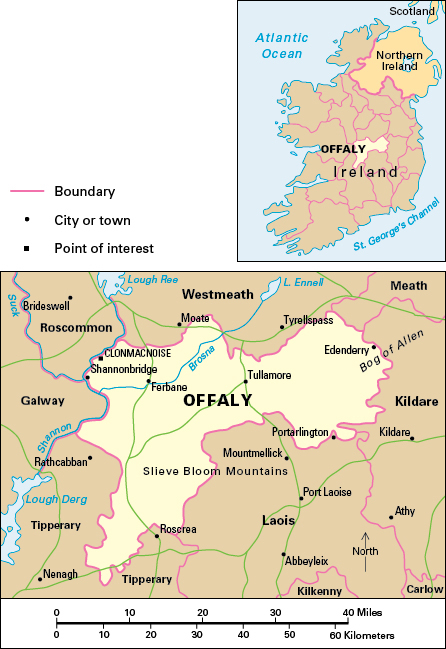Offaly, County, lies in the province of Leinster in the Republic of Ireland. It is an inland county in the heart of the Irish central lowland (see Leinster). County Offaly covers 770 square miles (1,998 square kilometers). The county has extensive peat bogs. Much of the rest of the land is agricultural. The principal town and service center is Tullamore.

About three-fourths of the people of County Offaly are Roman Catholics. Most of the rest belong to the Church of Ireland or have no religious affiliation.
The main industrial center in the area is Tullamore. Its industries produce building materials, meat products, and medical supplies. Important manufacturing industries in County Offaly include engineering and food processing. Producers of clothing and textiles were major employers in the county for a long time. However, the clothing and textile industry has declined since the late 1900’s. Many people employed in service industries work in health care, education, retail and wholesale trade, and transportation.
Beef cattle production is the leading type of farming in County Offaly. Farmers also raise dairy cattle, sheep, hogs, and poultry, and mixed farming is common. Crops include barley, potatoes, sugar beets, turnips, and wheat.
For many years, peat production was more important to the economy of County Offaly than to that of any other Irish county. Peat is partly decayed plant matter that has collected in bogs or other wetlands over long periods of time. From the mid-1900’s, peat-burning power stations operated at Ferbane, Rhode, and Shannonbridge, and a peat-briquette factory employed many people near Tullamore. Peat bogs play an important role in storing carbon that would contribute to climate change if released into the atmosphere. Concerns about climate change, as well as the availability of other power sources, led to the closure of peat-fired power plants by the 2020’s.
Most of County Offaly is flat lowland. The land slopes gently toward the River Shannon, which forms the western boundary of the county. Extensive peat bogs have developed in areas of poor natural drainage. The bogland in the east is part of the large Bog of Allen. New forests cover some bogland and areas of the Slieve Bloom Mountains, which lie along the border with County Laois in the south.
Archaeologists have found evidence that people lived in what is now County Offaly about 9,000 years ago. Much later, the territory was the ancient kingdom of Ui Failge (now spelled Uibh Fhaili). The greatest of the Irish Celtic monasteries was at Clonmacnoise. It was founded in the 500’s, overlooking the River Shannon.
After the Anglo-Norman invasion in the 1100’s, County Offaly remained under Irish control. There was a plan to colonize it under Queen Mary in the 1500’s, and it was called King’s County to honor her husband, King Philip II of Spain. The towns of Tullamore, Birr, and Edenderry developed in the period from the 1600’s to the 1800’s. The largest telescope in the world during the 1800’s was in the third Earl of Rosse’s famous observatory at Birr Castle.
